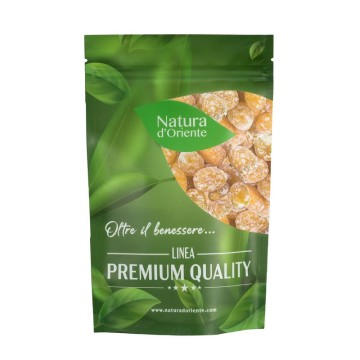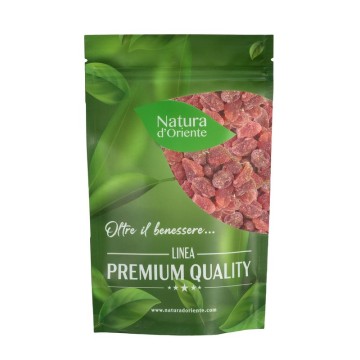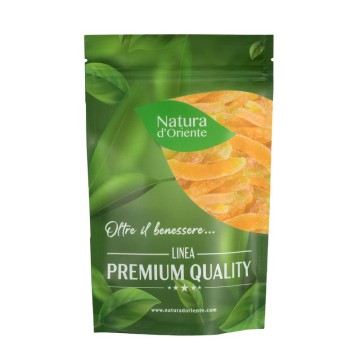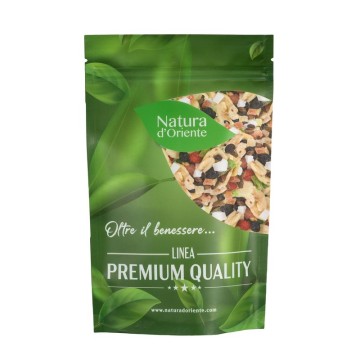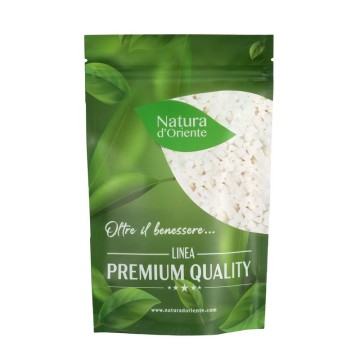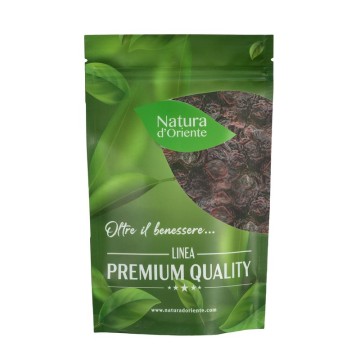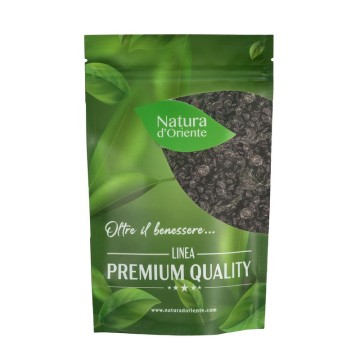Dehydrated banana chips
For those who love dehydrated fruit , dried bananas are one of the most sought after fruits, for their exquisite taste and beneficial nutritional characteristics.
Dehydrated banana chips: properties and benefits
Banana is a fruit very rich in potassium, magnesium and vitamin B6, mineral salts and vitamins which contribute to the well-being of the organism.
In particular, the banana has been considered a panacea for centuries for the control of gastric acidity and for the benefits it brings to the digestive function. From this point of view, also for its delicacy, it is often used in the diet to promote weight control.
It is also considered a fruit rich in antioxidants, capable of protecting against the action of free radicals.
For all these reasons and more, this exotic fruit has conquered a prestigious role on tables all over the world.
Origins and History of cultivation
The banana plant was probably born in Southeast Asia, and has spread over time to various territories and continents. From the 18th century it took on various botanical names, also based on the varieties, such as Musa sapientum or Musa balbisiana, up to Musa acuminata .
The origin of the term banana instead, it has various interpretations. Among the most authoritative is the one that derives the name from the Arabic word banan from the meaning of "finger".
In any case, already in ancient times both the Greek and Roman people knew the existence of the banana, thanks to the first expedition of Alexander the Great to India in 326 BC
A few centuries later, the banana tree reached East Africa thanks to the Arabs, who praised its therapeutic properties. Although present in Sicily but unknown in medieval Europe, this fruit was known to most people only through the stories of pilgrims, merchants and crusaders
In the 16th century the Portuguese, during their travels in the Indies, learned of this plant and began its cultivation in the Canaries, from where the Spaniards brought it to the Americas.
Today, the banana is the most sought after and consumed fruit in the world, after the apple. The banana plant grows throughout the tropical area , from India to the Philippines, from Costa Rica to Brazil and in many other countries where high temperatures favor its ripening.
Plant and Fruit
From the different species of the banana plant, belonging to the Musaceae, the most common are the Musa balbisiana and the Musa acuminata, which can also be grown in greenhouses.
The plant prefers the warm tropical climate to grow, and the stem reaches up to 7 meters.
In Italy the fruit is grown in Sicily, while in its wild form it is found in Bangladesh, China, India, Indonesia, Malaysia, Philippines, Sri Lanka, Vietnam and Thailand.
The fruit (actually a false berry) develops even without the flower having been fertilized, so it contains no seeds.
The banana grows from the center of the crown of leaves at the top, in a cluster called the helmet, which can also contain 150-200 bananas, with a total weight up to about 60 kg. It is known for its elongated shape that we all know, has a hard yellow-green skin, a sweet pulp, and as a fruit it can be stored in cold storage for export.
.jpg)
Its condition as a “climacteric” fruit, which ripens even after being separated from the plant, makes the banana interesting for conservation; we know this because the skin turns dark yellow and then with brown spots when it is overripe - ripening depends on the temperature.
There are several variants, not to be confused with each other or with other plants, such as the Passion Fruit Banana - Passiflora tripartita mollissima from the Andes mountain range.
Properties of the banana
The high potassium content, the sweet taste and the presence of other antioxidant active ingredients, over the centuries has pushed millions of people to include bananas in the diet.
Today, thanks to new conservation techniques, we it is also widespread the possibility of obtaining dried bananas, or banana chips, to use the banana as a tasty snack.
For its energetic and nutritional properties, the consumption of bananas is recommended for athletes, who can benefit from the presence of dopamine, noradreanalina, thiamine and serotonin, vasoactive substances.
The banana peel, in fact, is characterized by small dark patches: it is a normal ripening process due to the production of serotonin, by the tryptophan present in the peel of the fruit.
Bananas in the diet
Definitely aum
they enter the sense of satiety, they provide a lot of energy. Bananas are a source of vitamin C and thanks to the sugars present, and can improve concentration during study or work. This type of fruit, whether dehydrated or not, is particularly useful during periods of change of season, and in periods of fatigue, given the presence of iron in the fruit.
Their contribution of magnesium and potassium makes bananas important for athletes to recover these mineral salts dispersed during sports.
It is recommended to take bananas one hour before training, both for their high energy intake and because they help prevent cramps and relax the muscles.
The tryptophan present in bananas is an important element for the production of neurotransmitters such as serotonin, which help a good mood. Bananas are considered beneficial for the protection of cells from oxidative stress, also thanks to the presence of compounds such as carotenoids, phytosterols and other phenolic compounds.
Among the best known properties of the banana are those beneficial for digestion and stomach protection. It helps assimilation and counteracts acidity - this is why this fruit has been consumed for centuries to counteract the feeling of discomfort due to stomach pain and ulcer. Furthermore, the Indian tradition uses these fruits as food against diarrhea disorder.
The vitamin B2 contained in banana also promotes the health of hair, nails and skin.
In the dehydrated version, the banana suffers a loss of water and vitamins, unlike the fresh one. But the dehydration process favors a high concentration of fibers, proteins but also sugars and carbohydrates in dried bananas.
Nutritional values of Banana
You can also compare them in the Nutrition table below. In any case, dehydrated bananas are rich in minerals and vitamins of group B - in particular B2 and B6.
These fruits contain good amounts of potassium, phosphorus, magnesium, copper and iron, and other micronutrients.
In terms of calories, the values change according to the treatments, given that 100 grams of dried bananas develops about 519 calories, due to the presence of carbohydrates (58%) and fat (34%), but with a high fiber content.
Sometimes dehydrated banana chips are treated with coconut oil.
Are dehydrated bananas bad for our figure?
Like any fruit, it is always recommended to eat bananas, both fresh and dehydrated, in moderation. The dried versions are not a low-calorie food, and 100 grams of dehydrated bananas contain around 500 Kcal.
It should be remembered that the high concentration of calories and sugars compared to fresh bananas is determined by the dehydration process of the fruit, but we cannot even say that dehydrated sliced bananas make you fat, depending on the caloric needs of the person and the amount of dried bananas consumed.
Many dieticians suggest consuming this dehydrated fruit with balance, and above all not eating them at the end of a meal, after having already introduced an already high number of calories into the body.
How to consume or use dehydrated bananas in the kitchen
Dehydrated bananas can be used for different preparations, they constitute one of the protein snacks or a healthy meal, for those who do not give up on taste in calorie-controlled diets.
Dehydrated bananas can be used to make flour and desserts and integrate this unique flavor into any type of dish.
They can be mixed with yogurt, fruit salads, vegetable milk, snack cereal mixes, and dried bananas are also used for the preparation of sweets and biscuits, energy bars or enjoyed as simple snacks.
Dehydrated bananas: side effects and contraindications
There are no contraindications to taking, except for those who already have an intolerance to the banana fruit.
Furthermore, attention must be paid to the presence of some proteins contained in the pulp (protein Ba1, Ba2 and Mus XP 1): the banana could trigger allergic manifestations in particularly sensitive subjects.
If consumed in an excessive dose (a risk of gluttony since dehydrated bananas are often present in a convenient format), they can create problems for our body, perhaps due to sugar overload.
The Recipe: Banana Biscuits
Ingredients:
- 200 grams of self-rising flour
- 100 grams of dehydrated bananas
- 100 grams of butter
- 100 grams of cane sugar
- 30 grams of oat flakes
- 1 egg
- 1 pinch of salt
- Bana







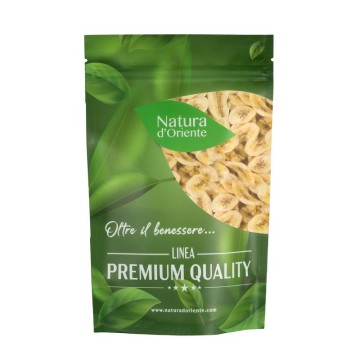





 No reward points for this product.
No reward points for this product.
.jpg)

